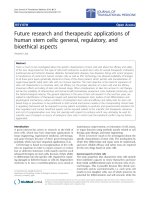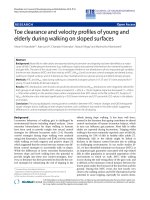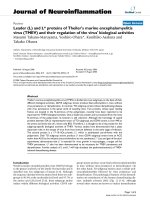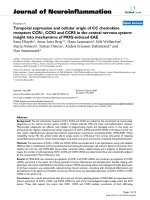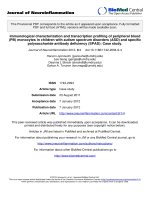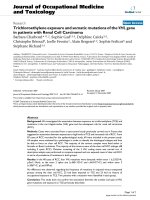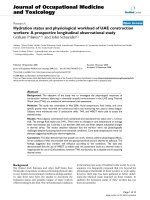Báo cáo hóa học: " Synthesis, magnetic and optical properties of core/shell Co1-xZnxFe2O4/SiO2 nanoparticles" pot
Bạn đang xem bản rút gọn của tài liệu. Xem và tải ngay bản đầy đủ của tài liệu tại đây (1.62 MB, 8 trang )
NANO EXPRESS Open Access
Synthesis, magnetic and optical properties of
core/shell Co
1-x
Zn
x
Fe
2
O
4
/SiO
2
nanoparticles
Emad Girgis
1,4*
, Mohamed MS Wahsh
2
, Atef GM Othman
2
, Lokeshwar Bandhu
3
and KV Rao
3
Abstract
The optical properties of multi-functionalized cobalt ferrite (CoFe
2
O
4
), cobalt zinc ferrite (Co
0.5
Zn
0.5
Fe
2
O
4
), and zinc
ferrite (ZnFe
2
O
4
) nanoparticles have been enhanced by coating them with silica shell using a modified Stöber
method. The ferrites nanoparticles were prepared by a modified citrate gel technique. These core/shell ferrites
nanoparticles have been fired at temperatures: 400°C, 600°C and 800°C, respectively, for 2 h. The composition,
phase, and morphology of the prepared core/shell ferrites nanoparticles were determined by X-ray diffraction and
transmission electron micr oscopy, respectively. The diffuse reflectance and magnetic properties of the core/shell
ferrites nanoparticles at room temperature were investigated using UV/VIS double-beam spectrophotometer and
vibrating sample magneto meter, respectively. It was found that, by increasing the firing temperature from 400°C to
800°C, the average crystallite size of the core/shell ferrites nanoparticles increases. The cobalt ferrite nanoparticles
fired at temperature 800°C; show the highest saturation magnetization while the zinc ferrite nanoparticles coated
with silica shell shows the highest diffuse reflectance. On the other hand, core/shell zinc ferrite/silica nanoparticles
fired at 400°C show a ferromagnetic behavior and high diffuse reflectance when compared with all the uncoated
or coated ferrites nanoparticles. These characteristics of core/shell zinc ferrite/silica nanostructures make them
promising candidates for magneto-optical nanodevice applications.
Keywords: nanostructures, oxides, cobalt ferrite, cobalt zinc ferrite, zinc ferrite, magnetic properties, diffuse
reflectance.
Introduction
Synthesis of magnetic nanoparticles have been intensively
pursued due to their unique f unctional pro perties and
their wide variety of potential applications in high density
magnetic recording [1-4], ferrofluids t echnology [5], bio-
medical drug delivery [6,7], and magnetic resonance ima-
ging [8,9], data storage, biosensors [10], biocompatible
magnetic nanoparticles for cancer treatmen t [11-14], and
magneto-optical devices [15-17] among others.
In recent years, Spinel ferrite nanoparticles have b een
widely studied because of their excellent and convenient
magnetic and electrical properties [18,19]. Among spinel
ferrites, CoFe
2
O
4
is of interest due to its high intrinsic
coercivity (5,400 Oe) and moderate saturation magneti-
zation (about 80 emu/g) as well as remarkable chemical
stability and mechanical hardness, which makes i t a
good candidate for recording media [20,21]. Also,
studies indicate that the magnetic properties of CoFe
2
O
4
depend strongly on its morphology a nd are greatly
affected by the size of the particles [22,23]. In addition,
the magnetic properties of spinel structure CoFe
2
O
4
can
be altered by cati on substitution. According to recent
research, Zn
2+
substituting for Co
2+
in CoFe
2
O
4
nano-
particles (Co
1-x
Zn
x
Fe
2
O
4
) exhibited improvement
in properties such as excellent chemical stability, high
corrosion resistivity, magneto-crystalline anisotropy,
magneto-striction, and magneto-optical properties.
Cobalt zinc ferrites nanoparticles have been prepared by
different methods, such as co-precipitation, usual cera-
mic technique, microwave-hydrothermal method, and
the solvothermal method [24-30].
In the present decade, core/shell structured nanoparti-
cles have received much attention, due to their enhanc ed
combinat ion of optical, electronic, and magnetic proper-
ties compared to those of single-component nanomaterials
[31]. Thus, coating magnetic nanoparticles with silica is
* Correspondence:
1
Solid State Physics Department, National Research Centre, 12311 Dokki,
Giza, Egypt
Full list of author information is available at the end of the article
Girgis et al. Nanoscale Research Letters 2011, 6:460
/>© 2011 Girgis et al; licensee Springer. This is an Open Access a rticle distributed under the terms of the Cre ative Commons Attribution
License ( g/licenses/by/2.0), which permits unrestricted use, distribution, and reproduction in any medium,
provided the original work is properly cited.
becoming a promising and important approa ch in the
development of magnetic nanoparticles for both funda-
mental studies as well as technological applications. Silica
formed on the surface of magnetic nanoparticles could
screen the magne tic dipolar attraction between magnetic
nanoparticles, which improves the dispersion of magnetic
nanoparticles in liquid media and protects them from
leaching in an acidic environment. In addit ion, the core/
shell structure enhances the thermal and chemical stability
of the magnetic nanoparticles due to the silica shell which
provides a chemically inert surface for magnetic nanopar-
ticles in biologic al systems. Therefore, silica-coated mag-
netic nanoparticles can be ea sily al lowed to conjugate its
surface with various functional group s [32,33]. Also, the
silica shell can enhance the optical properties of the nano-
particles [34]. The optical properties of the nanostructures
have been investigated earlier using many techniques,
among them is the diffuse reflectance spectroscopy [35].
The main objective of this study is to investigate the
effect of Zn
2+
partially substituting for Co
2+
in CoFe
2
O
4
nanoparticles (Co
1-x
Zn
x
Fe
2
O
4
; x = 0, 0.5, and 1) and shel-
ling with silica on the magnetic and optical properties of
the ferrite nanoparticles for a variety of magneto-optical
nanodevice applications. From a synthesis point of view
exploring the effect of firing temperatures (400°C, 600°C
and 800°C) is of interest to investigate.
Experimental work
The chemicals used for pr eparation of the samples were
ferric nitrate (Fe(NO
3
)
3
·9H
2
O, Mw = 404.00 g/mol,
Alpha Chemika™, Mumbai, India), c obalt (II) nitrate
(Co(NO
3
)
2
·6H
2
O, Mw = 291.04 g/mol, WinLab, UK),
and zinc nitrate (Zn(NO
3
)
2
·6H
2
O, Mw = 297.47 g/mol,
WinLab, Laboratory chemicals reagent fine chemicals),
citric acid monohydrate gritty, puriss, (C
6
H
8
O
7
·H
2
O,
Mw = 210.14 g/mol, Riedel-Dehaën, Sigma-Aldrich,
LaborChemikaLien,GmbH,St.Louis,MO,USA),
ammonia solution (30%), and tetraethyl orthosilicate
(TEOS, C
8
H
20
O
4
Si, Mw = 208.33 g/mol, Merck Schu-
chardt OHG, Hohenbrunn, Germany).
CoFe
2
O
4
, ZnF e
2
O
4
,andCo
0.5
Zn
0.5
Fe
2
O
4
nanoparticles
have been prepared using modified citrate gel method
[36,37]. Co(NO
3
)
2
·6H
2
Osolution(0.25M),Zn(NO
3
)
2
·6H
2
Osolution(0.25M),andFe(NO
3
)
3
·9H
2
Osolution
(0.25 M) were prepared by dissolving the metal nitrates in
distilled water. The prepared solutions were mixed in
molar ratio of Me
2+
/Fe
3+
=0.5(Me
2+
=Co
2+
,Zn
2+
,and
0.5 Co
2+
+0.5Zn
2+
for CoFe
2
O
4
,ZnFe
2
O
4
,and
Co
0.5
Zn
0.5
Fe
2
O
4
, respectively) under constant stirring to
get homogeneous solution with the heating rate of 5°C/
min up to 80°C for 1 h. This mixt ure solution was added
to the citric acid solution (0.25 M) maintaining the molar
ratio between metal nitrates solution and citric acid solu-
tion as 1:1 and stirred for 2 h. Ammonia was added to
reach pH equal to 7.5. Increasing the temperature during
the stirring process leads to form a viscous gel. The gel
was dried and fired at temperatures of 400°C, 600°C, and
800°C for 2 h to form CoFe
2
O
4
(CF), ZnFe
2
O
4
(ZF), and
Co
0.5
Zn
0.5
Fe
2
O
4
(CZF) nanoparticles.
Silica-coated magnetic nanoparticles were prepared
using the modified Stöber method. The nanoparticles
(fired at 400°C) were first treated by citric acid solution
(0.01 M) under const ant stirring for 1 h. The presence of
citrateincreasestheorganosilaneaffinityoftheparticle
surface. These particles were separated and washed with
distilled water several times. After that, the particles were
redispersed in a mixt ure of absolute ethanol (80 ml) and
distilled water (20 ml) the ammonia was added to the
solution as a catalyst. Subsequently, 6 ml of TEOS was
injected to the above solution, drop by drop at constant
stirring for 24 h at room temperature to ensure the hydro-
lysis, after that, the condensation of TEOS on the surface
of nanoparticles was achieved. Finally, the core/shell
CoFe
2
O
4
/SiO
2
,Co
0.5
Zn
0.5
Fe
2
O
4
/SiO
2
, and ZnFe
2
O
4
/SiO
2
particles were separated using external magnet, and
washed with ethanol and water several times. The samples
have been dried at 40°C for 24 h and fired at temperatures
400°C, 600°C, and 800°C, respectively, for 2 h.
The morphology of uncoated and coated nanoparticles
was studied using transmissi on electron microscopy,
TEM (JEOL 1230, JEOL, Tokyo, Japan). The phase com-
position and average crystallite size of the core/shell fer-
rite nanoparticles were i nvestigated using X-ray
diffrac tometer (Model Bruker D8 Advance (Bruker AXS,
Madison, WI, USA), Cu-Ka1(l = 1.54058 Å ) radiation
with secondary monochromator at a scanning speed of
1°/min). In addition, vibrating samples magnetometer
(model is Princeton FM-1, Princeton Applied Research,
Oak Ridge, TN, USA) and UV/VIS double-beam spectro-
photometer (model is no. Lambda 35, Perkin Elmer, Wal-
tham, MA, USA) were used to measure the magnetic
properties and diffuse reflectance of the prepared ferrite
nanoparticles, respectively.
Results and discussion
Figure 1a, b, c shows the X-ray diffraction patterns of
core/shell Co
1-x
Zn
x
Fe
2
O
4
/SiO
2
nanoparticles, in which x =
0, 0.5, and 1, respectively. All the strong peaks appeared at
2θ = 18.4°, 30.084°, 35.437°, 37.057°, 43 .058°, 53.445°,
56.973°, 62.585°, 70.78°, 74.009°, and 75.00° are indexed to
the crystal plane of spinel ferrite (Co
1-x
Zn
x
Fe
2
O
4
)struc-
ture (111), (220), (311), (222), (400), (422), (511), (440),
(620), (533), and (622), respectively. In addition, the inten-
sities of the peaks are found to increase by increasing the
firing temperature due to the increase of the crystalline
phase. From Figure 1a, b, it was observed that the X-ray
diffraction patterns (XRD) o f Co
0.5
Zn
0.5
Fe
2
O
4
nanoparti-
cles having the same crystal plane of CoFe
2
O
4
Girgis et al. Nanoscale Research Letters 2011, 6:460
/>Page 2 of 8
nanoparticles which confirms the formation of the good
spinel structure. In addition, no secondary phase was
detected in XRD patterns which ensure the purity of the
Co
0.5
Zn
0.5
Fe
2
O
4
nanoparticles. The average crystallite size
of Co
1-x
Zn
x
Fe
2
O
4
/SiO
2
nanoparticles were est imated
using the Scherrer’s formula; D =0.9l/(FWH M × cos θ),
where D is the crystallite size; FWHM is the observed full
width at half maximum; θ is the Bragg angle, and l is the
wavelength of the X- ray radiation (l = 1.54058 Å). In
addition, a broad peak at 2θ approximately 22-25° has
been detected in the samples coated with silica shell and
fired at 400°C for 2 h as shown in Figure 1a. This broad
peak is due to the presence of the amorphous silica. By
increasi ng th e firing temperature, amorphous silica starts
to disappear and only the diffraction peaks of spinel ferrite
Co
1-x
Zn
x
Fe
2
O
4
phase were detected due to the formation
of good core/shell structure. Figure 1c shows the XRD pat-
tern of the zinc ferrite/silica nanoparticles (ZFS) fired at
800°C. Similar phases have bee n observed as men tioned
aboveexceptforthepresenceofthreeweakdiffraction
peaks at 2θ = 33.194°, 48.94°, and 54.06° corresponding to
(410), (333), and (603) crystal planes of rhombohedral zinc
silicate phase. The latter phase arises because of solid state
reaction of ZnO resulting from small dissociation of
ZnFe
2
O
4
core at high temperature (800°C) with SiO
2
shell
forming Zn
2
SiO
4
phase.
Figure 2 shows the TEM images of zinc ferrite nano-
particles uncoated and coated with silica shell fired at
400°C. It was observed that the estimated average parti-
cle size of the zinc ferrite and zinc ferrite/silica nanopar-
ticles varies between 12 and 14 nm.
The hysteresis loops and the magnetic parameters
(saturation magnetization (Ms) and switching field
(Hc)) of the prepared ferrite nanoparticles fired at 400°
C and 800°C were measured at room temperature (27°
C) using vibrating samples magnetometer. Figure 3a
shows the hysteresis loops of uncoated cobalt ferrite
nanoparticles fired at 400°C and 800°C. It is clear that
by increasing the firing temperature from 400°C to
800°C, the Ms increased from 56.7 to 79.37 emu/g and
the Hc decreased from 1009.5 to 131.3 Oe. Increasing
the firing temperature leads to increase the crystal size
of the ferrite nanoparticles which reflects on the mag-
netization state by creating a multidomains state
instead of single-domain state. Multidomains need less
magnetic field to switch compared with the single
domain state. Accordingly, it was found that at large
crystallite size, the switching field decreases and the
magnetization saturation increases compared with the
smaller size. Figure 3b shows the hysteresis loops of
the coated cobalt ferrite nanoparticles fired at 400°C
and 800°C where a slight decrease in the saturation
magnetization compared with the uncoated nanoparti-
cles was observed. The slight decrease in the magneti-
zation saturation and increase in the switching field is
due to the coating effect, where each particle was sepa-
rated from its neighbors with silica shell which leads to
decrease the magnetostatic coupling between the parti-
cles. By increasing the firing temperature to 800°C, the
crystals will grow leading to i ncrease the magnetization
saturation and create a multidomains state.
1C
Figure 1 XRD patterns of core/shell CoFe
2
O
4
/SiO
2
(a),
Co
0.5
Zn
0.5
Fe
2
O
4
/SiO
2
(b), and ZnFe
2
O
4
/SiO
2
(c) nanoparticles.
Girgis et al. Nanoscale Research Letters 2011, 6:460
/>Page 3 of 8
On the other hand, the hysteresis loop is much wider
for the cobalt ferrite samples coated with silica shell
(CFS)andfiredat400°Ccomparedwithcobaltferrite
samples fired at 800°C. This confirms that by increasing
the firing temperature, the crystallite size increases lead-
ing to decrease of the switching field. Also, it was found
that, for the cobalt ferrite nanoparticles coated with silica
(CFS), the magnetic moment increases with increasing
the firing temperature from 400°C to 800°C. As men-
tioned earlier from the XRD analysis, with increasing the
firing temperature, the amorphous silica starts to disap-
pear and the diffraction peaks of spinel cobalt ferrite
phase only are found at higher temperatures due to the
formation of robust core/shell structure (Figure 1a). This
leads to creation of a very thin layer of cobalt ferrite sili-
cate at the surface of these cobalt ferrite nanoparticles
which decrease the effect of the amorphous silica shell
and hence increase the magnetic moment at higher firing
temperature.
The hysteresis loops of cobalt zinc ferrite nanoparticles
(Co
0.5
Zn
0.5
Fe
2
O
4
) uncoated and coated fired at 400°C and
800°C are shown i n Figure 4. When the Co
2+
ions in
cobalt ferrite samples is substituted by Zn
2+
ions
(Co
0.5
Zn
0.5
Fe
2
O
4
and ZnFe
2
O
4
), the magnetization satura-
tion and the switching field are found to decrease with
increasing the concentration of Zn
2+
ions. Accordingly,
Figure 2 TEM micrographs of ZnFe
2
O
4
nanoparticles uncoated (a) and coated with silica (b) fired at 400°C.
Figure 3 Hysteresis loops of CoFe
2
O
4
nanoparticles uncoated (a) and coated with silica shell (b).
Girgis et al. Nanoscale Research Letters 2011, 6:460
/>Page 4 of 8
the width of hysteresis loop and the magnetic moment
decrease due to the substitution of the magnetic Co ele-
ment by Zn element which is a non-magnetic material.
Core/shell ferrite nanoparticles show lower magnetization
saturation than the uncoated ferrite nanoparticles fired at
the same temperature, while the switching field increases
for the coated ferrite nanoparticles. This is due to the
effect of silica shell coating where each particle was sepa-
rated from its neighbors by the shell layer leading to
decrease the magnetostatic coupling between the particles.
Figure 5a shows the hyster esis loops of uncoated zinc
ferrite samples fired at 400°C, 600°C, and 800°C. It is clear
that the zinc ferrit e nanoparticles f ired at 400°C show a
ferromagnetic behavior while by increasing the firing tem-
perature to 600°C, the magnetization state of the zinc fer-
rite nanoparticles starts to transfer from the ferromagnetic
state to the paramagnetic state. With the increase of the
firing temperature up to 800°C the hysteresis loop of the
zinc ferrite nanoparticles shows a typical paramagnetic
behavior.
Figure 5b shows the hysteresis loops of core/shell zinc
ferrite nanoparticles coated with silica shell (ZFS) fired at
400°C and 800°C. It is clear that at 400°C, the zinc fer-
rite/silica nanoparticles show a ferromagnetic behavior
compared with the sample fired at 800°C which shows a
paramagnetic behavior.
Figure 4 Hysteresis loops of Co
0.5
Zn
0.5
Fe
2
O
4
nanoparticles uncoated (a) and coated with silica shell (b).
Figure 5 Hysteresis loops of ZnFe
2
O
4
nanoparticles uncoated (a) and coated with silica shell (b).
Girgis et al. Nanoscale Research Letters 2011, 6:460
/>Page 5 of 8
From X-ray diffraction results (Figure 1c), it is clear
that there are three weak diffraction peaks corresponding
to crystal planes of rhombohedral zinc silicate (Zn
2
SiO
4
)
phase were observed. The latter phase appears due to
solid state reaction of ZnO resulting from small dissocia -
tion of ZnFe
2
O
4
core at high temperature (800°C) with
SiO
2
shell leading to form Zn
2
SiO
4
phase. The Zn
2
SiO
4
phase has no magnetic property. This exp lains the trans-
formation of the magnetization state from ferromagnet ic
state to paramagneti c state with the increase of the firing
temperature from 400°C to 800°C. The Ms and Hc values
of the prepared coated and uncoated ferrite nanoparticles
are summarized in Table 1.
Figure 6 shows the diffuse reflectance spectra of various
cobalt ferrite, zinc ferrite, and cobalt zinc ferrite nanopar-
ticles uncoated and coated with silica shell which were
fired at 400°C (Figure 6a), 600°C (Figure 6b) and 800°C
(Figure 6c). It is clear that zinc ferrite nanoparticles
coated with silica shell exhibit the highest value of diffuse
reflectance percentage compared with all core/shell fer-
rite samples. In addition, the diffuse reflectance percen-
tage of zinc ferrite nanoparticles coated with silica
increases by increasing the firing temperature from 400°
C (37.4%) up to 800°C (44.64%). The diffuse reflectance
percent age of uncoated zinc ferrite nanoparticles, fired at
400°C, 600°C and 800°C decreased compared with zinc
ferrite nanoparticles coated with silica shell. This is
attributed to the effect of silica shell, which enhances the
optical properties of core/shell ferrite nanoparticles. On
the other hand, cobalt ferrite nanoparticles show a very
low diffuse reflectance compared with the other prepared
nanoparticles (zinc ferrite and cobalt zinc ferrite nano-
particles). Thi s i s due to the effect of the change of colo r
on the optical properties of the ferrite nanoparticles from
black at CoFe
2
O
4
,tobrownatCo
0.5
Zn
0.5
Fe
2
O
4
and to
orange at ZnFe
2
O
4
by increasing the Zn
2+
ions which
substitute the Co
2+
ions (Co
1-x
Zn
x
Fe
2
O
4
). In addition,
the presence of the silica shell plays an important role in
the optical properties enhancement of the prepared core/
shell f errite samples. When a beam of incident light
impinges on the surface of these core/shell nanoparticles,
only a s mall fraction is specularly reflected, while the
remainder penetrates into the mass and undergoes scat-
tering (multiple reflections, refractions, and diffraction in
all directions) as well as wavelength-dependent absorp-
tion within the colored material (diffused rays will lo se
some wavelengths during their walk in the m aterial, and
will emerge colored). Part of this radiation ultimately
leaves the mass in all directions and constitutes so-called
diffusely reflected light [38].
Figure 7 shows the photographs of CoFe
2
O
4
/SiO
2
(Figure 7a), Co
0.5
Zn
0.5
Fe
2
O
4
/SiO
2
(Figure 7b), and
ZnFe
2
O
4
/SiO
2
(Figure 7c) core/shell ferrite nanoparticles
fired at 400°C for 2 h, with and without an external
magnet effect. It can be seen that all t he core/shell
nanoparticles show manifestations of ferromagnetic
behavior as shown in the photographs where the nano-
particles were attracted to the external magnet. Also, it
is clear that the nanoparticles colors were changed from
black (CoFe
2
O
4
/SiO
2
), to brown (Co
0.5
Zn
0.5
Fe
2
O
4
/SiO
2
),
and to orange (ZnFe
2
O
4
/SiO
2
)byincreasingtheZn
2+
ion substituting for Co
2+
ions.
Conclusion
Core/shell Co
1-x
Zn
x
Fe
2
O
4
/SiO
2
(x = 0, 0.5, and 1) nano-
particles were prepared using modified citrate gel tech-
nique and coated with silica shell. The samples have
been fired at 400°C, 600°C, and 800°C, respectively. It
is concluded that cobalt ferrite nanoparticles fired at
800°C showed the highest magnetic properties, while
zinc ferrite nanoparticles coated with silica and fired at
800°C shows the best enhanced optical properties. X-ray
diffraction patterns show the presence of spinel ferrite
crystalline phase as the main phase in all prepared core/
shell ferrite nanoparticles. In addit ion, the average crys-
tallite size increases on increasing the firing temperature
from 400°C up to 800°C. Zinc ferrite nanoparticles
coated with silica shell and fired at 400°C show a ferro-
magnetic behavior and high diffuse reflectance com-
pared with all uncoated and coated nanoparticles due to
the presence of zinc ions and the silica shell which play
an important role on the optical properties enhance-
ment. The f iring temperatures as well as the crystallite
size parameters have great effect on the magnetic and
the opti cal properties of core/shell ferri te nanoparticles.
Core/shell ferrite nanoparticles coated with silica are
found to enhance the optical properties of the magnetic
nanoparticles. Core/shell zinc ferrite nanoparticles
coated with silica shell and fired at 40 0°C show promis-
ing results for photo-magnetic nanodevice applications
and for magneto-optical recording industry.
Table 1 Summary of the magnetization saturation and
switching field (H
C
) values at room temperature (27°C)
Sample code M
S
(emu/g) H
C
(Oe)
CF 400 56.7 1,009.5
CF 800 79.37 131.3
CFS 400 54.3 1,499
CFS 800 72.4 301.5
CZF 400 45.1 153.3
CZF 800 55.6 10
CZFS 400 42.25 185
CZFS 800 45.9 70
ZF400 3.26 62.99
ZFS 400 11.06 86
Girgis et al. Nanoscale Research Letters 2011, 6:460
/>Page 6 of 8
Figure 6 Diffuse reflectance spectra of core/shell nanoparticles fired at 400°C (a), 600°C (b), and 800°C (c).
(
a
)
(
b
)
(
c
)
Magnet
ZFS40
0
Figure 7 Photographs of CoFe
2
O
4
/SiO
2
(a), Co
0.5
Zn
0.5
Fe
2
O
4
/SiO
2
(b), and ZnFe
2
O
4
/SiO
2
(c) nanoparticles fired at 400°C.
Girgis et al. Nanoscale Research Letters 2011, 6:460
/>Page 7 of 8
Acknowledgements
We would like to thank the Swedish Research Foundation SIDA for
supporting the present work under grant # 348-2007-6992.
Author details
1
Solid State Physics Department, National Research Centre, 12311 Dokki,
Giza, Egypt
2
Refractories, Ceramics and Building Materials Department,
National Research Centre, 12311 Dokki, Giza, Egypt
3
Department of Materials
Science, Royal Institute of Technology, Stockholm, 100 44 Sweden
4
Advanced Materials and Nanotechnology Lab, CEAS, National Research
Centre (NRC), El-Behouth Street, 12311 Dokki, Giza, Egypt
Authors’ contributions
EG participated in the design of the study, measured and explained the
magnetic properties & SEM images and contributed in the writing of the
manuscript. MMSW participated in the conception and design of the study,
prepared the nanoparticles, explained the XRD analysis & diffuse reflectance
spectra and contributed in the writing of the manuscript. AGMO
participated in the explanation of the XRD analysis and helped to draft the
manuscript. LB participated in the measurement of magnetic properties. KVR
participated in the design and coordination and helped to draft the
manuscript. All authors read and approved the final manuscript.
Competing interests
The authors declare that they have no competing interests.
Received: 22 April 2011 Accepted: 20 July 2011 Published: 20 July 2011
References
1. Leslie-Pelecky DL, Rieke RD: Magnetic properties of nanostructured
materials. Chem Mater 1996, 8(8):1770-1783.
2. Himpsel FJ, Ortega JE, Mankey GJ, Willis RF: Magnetic nanostructures. Adv
Phys 1998, 47(4) :511-597.
3. Sugimoto M: The past, present and future of ferrites. J Am Ceram Soc
1999, 82(2):269-280.
4. Bate G: Magnetic recording materials since 1975. J Magn Magn Mater
1991, 100(1-3):413-424.
5. Pileni MP: Magnetic fluids: fabrication, magnetic properties, and
organization of nanocrystals. Adv Funct Mater 2001, 11(5):323-336.
6. Liu C, Zou BS, Rondinone AJ, Zhang ZJ: Reverse micelle synthesis and
characterization of superparamagnetic MnFe
2
O
4
spinel ferrite
nanocrystallites. J Phys Chem B 2000, 104(6):1141-1145.
7. Sun C, Lee JSH, Zhang M: Magnetic nanoparticles in MR imaging and
drug delivery. Adv Drug Deliv Rev 2008, 60:1252-1265.
8. Shultz MD, Calvin S, Fatouros PP, Morrison SA, Carpenter EE: Enhanced
ferrite nanoparticles as MRI contrast agents. J Magn Magn Mater 2007,
311:464-468.
9. Zhen L, He K, Xu CY, Shao WZ: Synthesis and characterization of single-
crystalline MnFe
2
O
4
nanorods via a surfactant-free hydrothermal route.
J Magn Magn Mater 2008, 320:2672-2675.
10. Schmid G: Nanoparticles: from theory to application. Weinheim: Wiley-
VCH; 2004.
11. Jordan A, Scholz R, Wust P, Schirra H, Schiestel T, Schmidt H, Felix R:
Endocytosis of dextran and silan-coated magnetite nanoparticles and
the effect of intracellular hyperthermia on human mammary carcinoma
cells in vitro. J Magn Magn Mater 1999, 194:185-196.
12. Kim DH, Nikles DE, Johnson DT, Brazel CS: Heat generation of aqueously
dispersed CoFe
2
O
4
nanoparticles as heating agents for magnetically
activated drug delivery and hyperthermia. J Magn Magn Mater 2008,
320:2390-2396.
13. Mornet S, Vasseur S, Grasset F, Duguet E: Magnetic nanoparticle design
for medical diagnosis and therapy. J Mater Chem 2004, 14:2161-2175.
14. Wada S, Tazawa K, Furuta I, Nagae H: Antitumor effect of new local
hyperthermia using dextran magnetite complex in hamster tongue
carcinoma. Oral Dis 2003, 9:218-223.
15. Bentivegna MF, Nyvlt M, Ferre J, Jamet JP, Brun A, Visnovsky S, Urban R:
Magnetically textured γ -Fe
2
O
3
nanoparticles in a silica gel matrix:
optical and magneto-optical properties. J Appl Phys 1999, 85(4):2270-2278.
16. Hocini A, Boumaza T, Bouchemat M, Royer F, Jamon D, Rousseau JJ:
Birefringence in magneto-optical rib waveguides made by SiO
2
/TiO
2
doped with g-Fe
2
O
3
. Microelectron J 2008, 39:99-102.
17. Jamon D, Donatini F, Siblini A, Royer F, Perzynski R, Cabuil V, Neveu S:
Experimental investigation on the magneto optic effects of ferrofluids
via dynamic measurements. J Magn Magn Mater 2009, 321:1148-1154.
18. Kaiser M: Effect of nickel substitutions on some properties of Cu-Zn
ferrites. J Alloy Compd 2009, 468(1-2):15-21.
19. Iqbal MJ, Siddiquah MR: Electrical and magnetic properties of chromium-
substituted cobalt ferrite nanomaterials. J Alloy Compd 2008, 453(1-
2):513-518.
20. Lee JG, Park JY, Kim CS: Growth of ultra-fine cobalt ferrite particles by a
sol-gel method and their magnetic properties. J Mater Sci 1998,
33(15):3965-3968.
21. Okuno SN, Hashimoto S, Inomata K: Preferred crystal orientation of cobalt
ferrite thin films induced by ion bombardment during deposition. J Appl
Phys 1992, 71:5926-5929.
22. Montana S, Santi M: Nanostructures and magnetic properties of cobalt
ferrite (CoFe
2
O
4
) fabricated by electrospinning. Appl Phys Mater Sci
Process 2009, 97(1):167-177.
23. Chiu WS, Radiman S, Abd-Shukor R, Abdullah MH, Khiew PS: Tunable
coercivity of CoFe
2
O
4
nanoparticles via thermal annealing treatment.
J Alloy Compd 2008, 459(1-2):291-297.
24. Vaidyanathan G, Sendhilnathan S: Characterization of Co1-xZnxFe2O4
nanoparticles synthesized by co-precipitation method. Phys B: Phys
Condens Matter 2008, 403:2157-2167.
25. Akther Hossain AKM, Tabata H, Kawai T: Magnetoresistive properties of
Zn
1-x
Co
x
Fe
2
O
4
ferrites. J Magn Magn Mater 2008, 320(6):1157-1162.
26. Islam MU, Aen F, Niazi SB, Azhar Khan M, Ishaque M, Abbas T, Rana MU:
Electrical transport properties of CoZn ferrite-SiO
2
composites prepared
by co-precipitation technique. Mater Chem Physic 2008, 109(2-3):482-487.
27. Arulmurugan R, Vaidyanathan G, Sendhilnathan S, Jeyadevan B:
Thermomagnetic properties of Co
1-x
Zn
x
Fe
2
O
4
(x = 0.1-0.5) nanoparticles.
J Magn Magn Mater 2006, 303(1):131-137.
28. Tawfik A, Hamada IM, Hemeda OM: Effect of laser irradiation on the
structure and electromechanical properties of Co-Zn ferrite. J Magn
Magn Mater 2002, 250:77-82.
29. Kim CK, Lee JH, Katoh S, Murakami R, Yoshimura M: Synthesis of Co-, Co-
Zn and Ni-Zn ferrite powders by the microwave-hydrothermal method.
Mater Res Bull 2001, 36(12):2241-2250.
30. Hou C, Yu H, Zhang Q, Li Y, Wang H: Preparation and magnetic property
analysis of monodisperse Co-Zn ferrite nanospheres. J Alloy Compd 2010,
491(1-2):431-435.
31. Lu QH, Yao KL, Xi D, Liu ZI, Luo XP, Ning Q: A magnetic separation study
on synthesis of magnetic Fe oxide core/Au shell nanoparticles.
Nanoscience 2006, 11(4):241-248.
32. Deng YH, Wang CC, Hu JH, Yang WL, Fu SK: Investigation of formation of
silica-coated magnetite nanoparticles via sol-gel approach. Colloid Surface
Physicochem Eng Aspects 2005, 262(1-3):87-93.
33. Sounderya N, Zhang Y: Use of core/shell structured nanoparticles for
biomedical applications. Recent Patents on Biomedical Engineering 2008,
1:34-42.
34. Huaiping C, Toftegaard R, Arnbjerg J, Ogilby PR: Silica - coated gold
nanorods with a gold overcoat: controlling optical properties by
controlling the dimensions of a gold - silica - gold layered nanoparticle.
Langmuir 2010, 26(6):4188-4195.
35. Morales AE, Mora ES, Pal U: Use of diffuse reflectance spectroscopy for
optical characterization of un-supported nanostructures. Revista Mexicana
De Fisica S 2007, 53(5):18-22.
36. Turtelli RS, Duong GV, Nunes W, Grössinger R, Knobel M: Magnetic
properties of nanocrystalline CoFe
2
O
4
synthesized by modified citrate-
gel method. J Magn Magn Mater 2008, 320:e339-e342.
37. Varma PCR, Manna RS, Banerjee D, Varma MR, Suresh KG, Nigam AK:
Magnetic properties of CoFe
2
O
4
synthesized by solid state, citrate
precursor and polymerized complex methods: A comparative study.
J Alloy Compd 2008, 453:298-303.
38. Torrent J, BarrόnV:Diffuse reflectance spectroscopy of iron oxides.
Encyclopedia of Surface and Colloid Science New York: Marcel Dekker, Inc.;
2002, 1438-1446.
doi:10.1186/1556-276X-6-460
Cite this article as: Girgis et al.: Synthesis, magnetic and optical
properties of core/shell Co
1-x
Zn
x
Fe
2
O
4
/SiO
2
nanoparticles. Nanoscale
Research Letters 2011 6:460.
Girgis et al. Nanoscale Research Letters 2011, 6:460
/>Page 8 of 8

